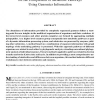Free Online Productivity Tools
i2Speak
i2Symbol
i2OCR
iTex2Img
iWeb2Print
iWeb2Shot
i2Type
iPdf2Split
iPdf2Merge
i2Bopomofo
i2Arabic
i2Style
i2Image
i2PDF
iLatex2Rtf
Sci2ools
RECOMB
1999
Springer
1999
Springer
Evolution of metabolisms: a new method for the comparison of metabolic pathways
The abundance of information provided by completely sequenced genomes de nes a starting point for new insights in the multilevel organization of organisms and their evolution. At the lowest level enzymes and other protein complexes are formed by aggregating multiple polypeptides. At a higher level enzymes group conceptually into metabolic pathways as part of a dynamic information-processing system, and substrates are processed by enzymes yielding other substrates. A method based on a combination of sequence information with graph topology of the underlying pathway is presented. With this approach pathways of different organisms are related to each other by phylogenetic analysis, extending conventional phylogenetic analysis of individual enzymes. The new method is applied to pathways related to electron transfer and to the Krebs citric acid cycle. In addition to providing a more comprehensive understanding of similarities and differences between organisms, this method indicates differe...
| Added | 04 Aug 2010 |
| Updated | 04 Aug 2010 |
| Type | Conference |
| Year | 1999 |
| Where | RECOMB |
| Authors | Christian V. Forst, Klaus Schulten |
Comments (0)

